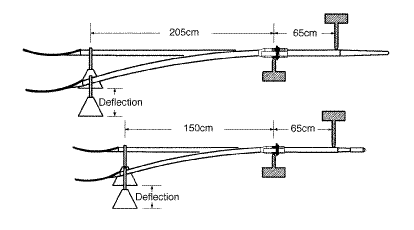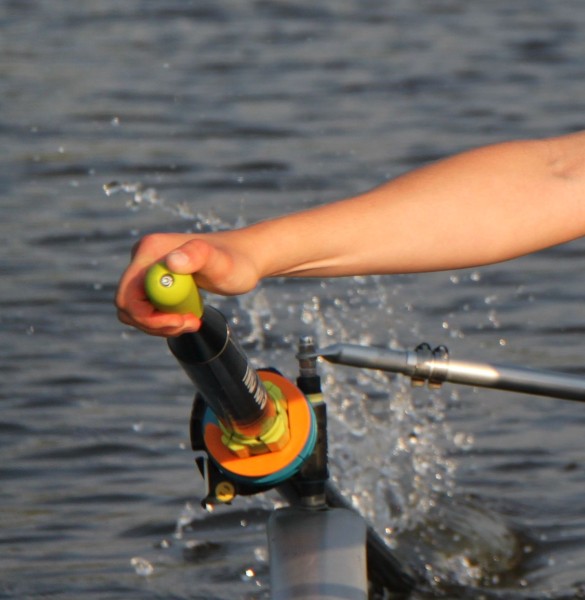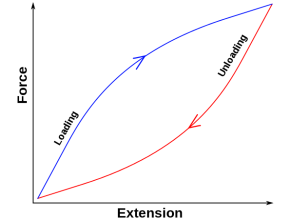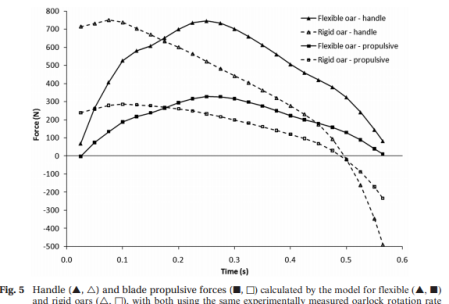
Oar Shaft Stiffness
Oar Bending has been discussed in various venues before, but the descriptions often remain diffuse and imprecise. Without claiming this would be an exhaustive description of the mechanics, I want to reiterate the basic mechanics and discuss what effect oar shaft stiffness may have on rowing performance.

Fig. 1: Measuring shaft stiffness, according to Conecpt2.
Source: http://www.concept2.com/oars/oar-options/shafts/stiffness
The Oar represents a first class lever with the gate being the fulcrum (see [1] for discussion). “Bend” describes the deflection of the oar under load applied to the blade with a “softer” shaft having more deflection at similar load than a “stiff” shaft. Various ways exist to measure shaft stiffness, for example this is the method used by Concept2 to describe their oar shafts (see Fig. 1).
Let’s for a second assume we have a theoretical shaft of infinite stiffness, i.e. a shaft that has no deflection under any load. In this case the ratio of blade and handle force (called “gearing ratio”) would be exactly that of inboard to outboard. Since outboard is in practice is always longer than inboard, the force at the blade is smaller than the force at the handle. A really accurate description though would need to consider that the point of force application on the handle is not the tip of the handle but rather somewhere near the center of the hands (see Fig. 2).

Fig. 2: The point of handle force application is not at the tip of the handle.
Furthermore, it moves throughout the stroke, especially in sweep rowing where the force applied by the inner and outer hand are not balanced. Similar thoughts need to be applied to the blade. See this paper by Dr. Kleshnev for more information. Leaving the issue of the actual gearing ratio aside, the transfer of mechanical energy is unaffected by a lever of perfect stiffness. All the work performed on the handle is transferred to the blade, even though the force on the handle is larger than on the blade. This is because the mechanic work on the handle $$W=F*s$$ is performed with a higer force on a shorter distance while the work on the blade has lower force but longer distance.
Shafts in the real world of course do not have infinite stiffness and deflect under load. What effect does this have? We need to look at this from two different perspectives: The energy balance and the force balance.
Let’s look at energy balance first. A bent oar stores mechanical energy, very much like a spring. It is however not a perfect storage for mechanical energy but exhibits elastic hysteresis due to internal friction in the shaft (Fig. 3). Some of the energy put into the shaft will thus dissipate as heat and cannot be recovered for propulsion.

Fig. 3: Elastic Hysteresis.
Source: https://en.wikipedia.org/wiki/Hysteresis
This phenomenon is one of the reasons for the often claimed “inefficiency” of softer shafts.
Second, we need to look at the change in forces introduced by shaft flexibility. When the blades enter the water, the shaft is fully relaxed. The subsequent force application on the handle by the rower now however has a different temporal loading profile. When the shaft flexes, the handle force profile will ramp up slower because the oar handle needs to travel a further distance until the shaft can produce a counter force for handle force at the same magnitude as if the shaft were stiffer. In Figure 5 below we can see the result of simulating how shaft stiffness affects handle force and blade force (called “blade propulsive force” in the figure), assuming an identical rotation profile of the gate between both simulation runs.

Fig 4: Source: “Modelling the effect of oar shaft bending during the rowing stroke”, A. Sliasas and S. Tullis, Proceedings of the Institution of Mechanical Engineers, Part P: Journal of Sports Engineering and Technology December 2011 vol. 225 no. 4 265-270.
We can observe multiple interesting results in this figure. First, we can see the effect of gearing at work: blade forces are much smaller than handle forces. Second, a more rigid oar requires a much more front-loaded handle force profile if the rower was to maintain a similar gate rotation profile. Third, handle force becomes negative for the simulated rigid oar towards the end of the drive. This is of course an unrealistic result and a consequence of the simulation constraint (identical gate rotation profile). Nonetheless, it is a consequence of the blade velocity falling below shell velocity towards the end of the drive.
This hints at a realistic problem though: as the shell accelerates throughout the drive and handle force decreases naturally after the leg drive is finished because the weaker trunk and arms muscles are at work, the crew must maintain a positive difference between blade and shell velocity in order not to stop the boat. A shaft that is still flexed at the end of the drive phase helps maintaining this positive difference as it ensures positive blade force is applied. Problematic however is a shaft that is still flexed during extraction of the blades. Not only will it make extraction of the blades more difficult, but also the potential elastic energy stored in the shaft can not be efficiently recovered for propulsion of the rower+boat system.
As the rower applies force at the relaxed handle at the catch, the shaft flexes and will store mechanical energy (called elastic potential energy). This portion of mechanical effort of the rower is thus not available for propulsion at this point in time. The total amount of mechanic energy stored in the shaft has been estimated to be between 2.5% (stiff) and 3.3% (soft) of total work per stroke.
What effect does storing mechanical energy in the shaft have for the propulsion of the rower boat system? There are a lot of factors at play here so that it is difficult to make a reasonable judgement about the advantages or disadvantages of using a softer or stiffer shaft. Let’s recap:
- Energy stored in the shaft during the beginning of the drive phase does not accelerate the boat, which would be advantageous to maximize fluid drag efficiency. Theoretically, using a stiffer shaft should result in a more front-loaded boat acceleration profile which would be easy to measure with an acceleration measurement system like Rowing in Motion
- Energy release of the shaft is subject to hysteresis (probably of marginal effect), energy may thus be lost
- A flexible shaft helps maintain positive blade force towards the end of the drive phase
- The change in handler force profile due to a more flexible shaft may be more suited to the physiological capabilities of rowers (working angles of muscles, isometric vs. isokinetic force, muscle contraction speeds)
- Flexion of the shaft has a considerable influence on the blade force profile, which in combination with the variation of blade propulsive efficiency at different angles may lead to a higher or lower total blade efficiency for the stroke
- Softer shafts may be lighter (decreasing oar inertia and the work required to accelerate the oar) and of smaller diameter (decreasing wind resistance)
The interplay of all these factors is complex.
A recent thesis by Brock Laschowski from the university of Western Ontario, Canada (supervised by Dr. Volker Nolte) has set out to empirically test the effect of varying oar shaft stiffness. The full text of the thesis is unfortunately still under embargo, but the available abstract indicates that no statistically significant differences could be found.
I hope this article gives a reasonable overview of the different arguments to consider when choosing oar shaft stiffness. Curious whether changing oars and inboard/outboard setting has any effect on your stroke? Give Rowing in Motion a try to measure it and see for yourself.
[1]: here has been some discussion about this statement in the comments. My current thinking is that from the perspective of the rower, the oar represents a first class lever with the gate as a fulcrum. From the perspective of the water through which the boat is propelled, the blade’s tip is the fulcrum (although this fulcrum moves quite a bit!) and the oar is a second class lever. Happy to discuss this in the comments!)

Not so sure that an oar is a first class lever. We aren’t moving the water past the boat; we’re moving the boat past the water. The water is effectively stationary and the boat is moving. I’d suggest therefore that an oar is a second class lever; fulcrum at the blade in the water, load at the gate and the effort at the handle. Of course there’s some slip of the blade through the water at least before it’s loaded and maybe during the drive. Perhaps it exhibits attributes of both first and second class levers with he latter being the dominant one.
Hi Demot, interesting point and thanks for pointing it out. The FISA rule book (http://www.worldrowing.com/uploads/files/FISA_rule_book_EN_2011_HR_sans_traitsCoupes(12.05)_.pdf) e.g. states that oars should be used as levers of the second order for propulsion of a rowing boat. I like your description that it exhibits characteristics of both.
If we look at it from the frame of reference “water” it is indeed a second class lever. If we look at it from the frame of reference “boat” however, it looks to me more like a first class lever. In any case, the classification is irrelevant with regards to the formula at work describing the lever.
Recently using “skinnys” for sculling so find this analysis very interesting. Since differences in stiffness may be have marginal results, am wondering if affects on the body might be more important. Is a more flexible scull easier on the lower back? Does a sculler have to be stronger in order to keep the “stored energy” from dissipating near the finish after the legs are down? Is a lighter scull-like a “skinny” easier to use because of it’s lighter weight?
Other questions related more to Physics: Does a flexed shaft change or degrade the Bernoulli affect on the blade by allowing more “slippage”?
Hi Tim, these are very interesting questions indeed. One thing to be said regarding the whole “easy on the back”, “harder to pull” descriptions is that the handle force profile may indeed change with oar shaft stiffness. But (and this is important)
– handle force is created by muscles pulling on the handle, not the other way round. The shaft doesn’t “overload” any muscles, a stiffer shaft may only allow you to ramp up handle force faster.
– all a rower has to do at the end of the drive to ensure the shaft dissatipates its energy into the water is to ensure the shaft doesn’t pull his hands away from the body.
Regarding the effect of shaft stiffness on blade slippage: A bend shaft allows gate angle and blade angle to differ, and quite significantly so. This is indeed interesting but would require detailed simulation.
Please see the article entitled “The effects of oar-shaft stiffness and length on rowing biomechanics” published in the Journal of Sports Engineering and Technology for full details [http://pip.sagepub.com/content/early/2015/05/05/1754337115582121?papetoc]
Hi Brock, thanks for including the link. I’ve read the article but many interested rowers (i.e. those without university or library access) won’t be able to access it behind Sage’s paywall… That’s why I had included the link to your thesis instead.
If interested, the University of Western Ontario [Canada] recently published a short story about this research. Please click the following link [http://news.westernu.ca/2015/06/research-floats-revolutionary-idea-on-rowing/]
Another manuscript entitled “Modeling the
deflection of rowing oar-shafts” is currently under peer-review and should
be published soon. This article will provide an unprecedented looked into the
mechanical properties of rowing oar-shafts of different stiffness’ and lengths.
While previous anecdotal work by Kleshnev and others have been satisfactory,
this upcoming publication will provide the scientific backing to finally put these
questions to rest once and for all.
Great to have you comment here. This is absolutely fantastic! Is there any chance you can arrange for an open access policy for the article?
A note on the energy balance. I’d question the assumption of internal friction in the shaft that would dissipate some energy via heat. Elastic hysteresis is important for rubber and maybe for stresses near the yield point, but this is not the case for a bent shaft.
You might instead want to assume perfect linear elasticity, i.e. the oar simply obeys Hooke’s law. Therefore, it can store energy, but it cannot dissipate energy and the statement about the “inefficiency” of softer shafts is misleading.
I fully agree with you, the hysteresis of a shaft is probably marginal (and I say so in the summary as well). Sorry if I made it sound like I would agree with that in the first part, but I felt it was important to mention it as it’s a commonplace myth.